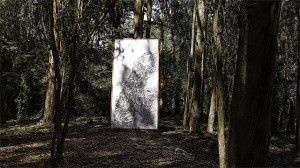A sign in front of the San Francisco Museum of Modern Art, now closed for a three-year expansion, reads “We’ve temporarily moved…everywhere.” Though the building has gone dark, the programming has ramped up and spread out — collaborative projects are being presented in a variety of conventional and unconventional partnering venues, including, at present, the Contemporary Jewish Museum and Crissy Field. The 2012 SECA Art Awards, debuting to the public this week, push the boundaries of the museum well beyond what one might imagine, including a eucalyptus grove in the Presidio, the alcoves of the Neptune Society Columbarium, the open air plaza of downtown Oakland, and the expansive public platform of the Internet. In the absence of brick and mortar galleries, SFMOMA has considered the whole Bay Area as a possible exhibition site — and the experiments have yielded exciting new public platforms. The results challenge our expectations of how and where museums present art and will undeniably expand SFMOMA’s understanding of its community and audience.
The SECA Award — bestowed by the SFMOMA’s Society for the Encouragement of Contemporary Art — is a key point of professional recognition among Bay Area artists. It typically includes funds for a new commission and an exhibition in the museum. With this year’s award, artists were invited to propose site-specific projects in venues of their own choosing. All four of the awardees seized this opportunity to simultaneously expand their practices and explore new terrain.

David Wilson, Frog Woman Rock (installation view) from Arrivals, 2013; commissioned by SFMOMA, courtesy the artist; c. David Wilson; photo: Ian Reeves
Oakland-based David Wilson decided to pursue his long considered notion of a “forest gallery” and created a massive landscape drawing for presentation in the midst of the Presidio, near an overlook with breathtaking views of the San Francisco National Cemetery, the Golden Gate Bridge and the surrounding Bay. This is the first in a series of six site-specific projects, titled Arrivals, organized around self-directed walking tours, live musical performances, communal gatherings, hidden audio recordings, and landscape drawings presented in outdoor locations around San Francisco. Each week a new map will be distributed from an “informational trailhead” installed at the now closed SFMOMA entrance; an enclosed bulletin board will also present materials collected by the artist over the course of the project.

Josh Faught, BE BOLD For What You Stand For, BE CAREFUL For What You Fall For (installation view), 2013; commissioned by SFMOMA, courtesy the artist and Lisa Cooley, New York; c. Josh Faught; photo: Ian Reeves
The extraordinary Neptune Society Columbarium houses San Francisco-based Josh Faught’s three hand-woven sculptures in various alcoves of its 1897 neo-classical building. Originally part of a cemetery operated by the Odd Fellows, a global altruistic fraternal organization dating back to 17th-century Britain, the Columbarium fell into neglect from 1934 through 1979. It was restored and has since been maintained by caretaker Emmitt Wilson, once referred to as “the man who keeps the dead alive” in the now defunct Argus Newspaper. As the restoration and reopening of the Columbarium coincided with the AIDS crisis of the 1980s and ’90s, these non-denominational resting grounds reflect the far reaching effects of the epidemic — and formulate a unique time capsule, as it were, of a wide-reaching community. The ashes of artist Martin Wong, for example, who passed away from an AIDS-related illness in 1999, are interred at the Columbarium, alongside those of his parents.




